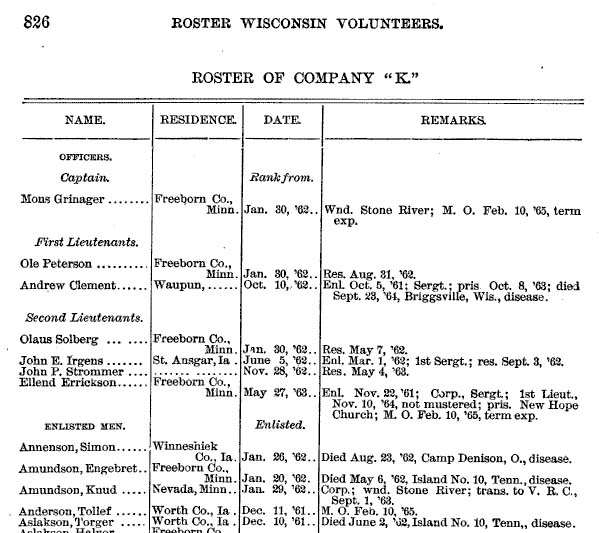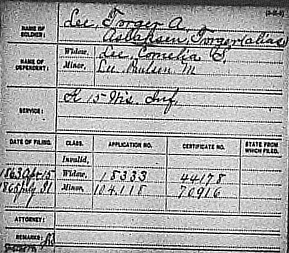Torger Aslakson Lee
Many family members have heard that Tarje and Ole had a brother who 'stayed behind in Wisconsin' and was killed in the Civil War. Ole and Tarje had no brother who stayed behind in Wisconsin when they settled in Minnesota. Torjus Haraldson, who married their sister Aase, served in the Civil War and suffered eye damage blamed on that service, but he did not die.
Ole and Tarje, along with Kristi, Aase and Tone lived with Kristi's brother Aslak Lee for a half dozen years when they arrived in Wisconsin. Aslak had three sons: Torger, Ole, and Egar.
Torger may have been more like an older brother than first cousin to brothers Ole and Tarje. When their sister Tone married Torger's brother Ole, Torger became Tone's brother-in-law as well. The close and complicated relationship between these two families easily explains the oral tradition of the "lost brother killed in the Civil War."
Torger moved to Iowa with the rest of his family in the 1850's but he volunteered for service in the 15th Wisconsin Regiment in 1861.
Torger died in June of 1862 on Island Number 10 in Tennessee. Records indicate that he was buried in the Mississippi River National Cemetery near Memphis. There is a monument which may or may not mark his final resting place in North Shellrock Cemetery in Iowa.
Torger is listed as Torger Aslakson in most Civil War databases.
The Vesterheim database indicates that Torger, a resident of Worth County, Iowa,
was married and had blue eyes, red hair, and stood 5' 3 3/4" tall
 |
About the 15th Wisconsin Regiment, Company K
The 15th was known as the "Scandinavian Regiment" because its officers and enlisted men were almost all immigrants, predominantly from Norway, but also from Denmark and Sweden. While men from these countries served in many different Civil War units, Federal and Confederate, the 15th was the only 'all Scandinavian' regiment on either side.
Company K called itself the "Clausen's Guards" in honor of the 15th's first Chaplain, Claus L. Clausen. Soldiers in Company K were recruited by Captain Mons Grinager from the Scandinavian communities in Freeborn, Fillmore, and Mower counties in Minnesota, and from Emmett, Mitchell, Winneshiek, and Worth counties in Iowa. There were a few soldiers whose homes were in Wisconsin. The volunteers spent the first few months of their enlistment in training at Camp Randall outside Madison, Wisconsin. In early March, 1862, the 15th left Camp Randall for the war.
State Historical Society of Wisconsin. Sketch by Ole Dahl of Company "H"
Island Number 10
Island Number Ten has since eroded and been washed away, but during the Civil War it was located at a critical double bend in the Mississippi at the Tennessee-Kentucky-Missouri border. The double bend (an "S" on its side) had New Madrid Missouri at its northwest corner and Island Number 10 at its southeast corner. The Confederates had gun placements on the island and on the east side of the river opposite the island. It was therefore necessary to capture the river bank before attacking the island. The Yankees dug a canal through a swamp to New Madrid. It was deep enough for troop transports to ferry most of the 25,000 Union troops that would occupy the town. The canal was not deep enough for ironclads, and they were needed to protect the troops as they crossed the river to the island.
The Navy began shelling the island March 16, 1862. The ironclads were unable to get past the island during the day because their flanks had no armor to protect them from rebel fire from the island. On April 3, 1862, the USS Carondelet was able to sneak past the island under cover of night, followed by the USS Pittsburgh the following night. Under the protection of the gunboats, Union troops landed on the island.
The 15th Regiment returned to New Madrid while the surrender of about 7,000 Confederate defenders was arranged. The rebels left the island on April 7th and the Scandinavians were sent to occupy the Kentucky shore. There they took possession of enemy camps that were well stocked with food, munitions, and other provisions. As other troops moved on, the Fifteenth was left to guard the Island, and to gather up and protect the munitions and other provisions which had been captured. The situation was found to be quite unhealthy, and the duty of the regiment was very severe and laborious. It seems likely that these arduous conditions cost Torger his life after less than three months of duty 'in the war zone.'
 |
Pension application by Torger's widow, Cornelia. |
![]()
|
Copyright 1998-2019 Tarje Grover Family |